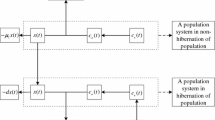Abstract
In this work, we consider a single population-hibernation model with genic mutation, birth pulse and impulsive input toxin in a polluted environment. By the theories of discrete dynamical system and the methods of mathematical analysis, the population-extinction periodic solution \((0,0,c_{o}(t),c_{e}(t))\) of system (2.1) is proved to be globally asymptotically stable. System (2.1) is proved to be permanent. Our results indicate that the genic mutational rate and the amount of the impulsive inputting toxin play important roles on the permanence of system (2.1). Our results also provide reliable tactics for biological resource management.




Similar content being viewed by others
References
Samuel, S. (1970). Epstein, control of chemical pollutants. Nature, 228, 816–819.
Waxman, D., & Peck, J. R. (1999). Sex and adaptation in a changing environment. Genetics, 153, 1041–1053.
Bello, Y., & Waxman, D. (2006). Near-periodic substitution and the genetic variance induced by environmental change. Journal of Theoretical Biology, 239, 152–160.
Wang, X., et al. (2007). Environmental factors and birth defect. Medicine and Philosophy, 28, 18–21 (in Chinese).
Wang, L. C. H., & Lee, T. F. (1996). In M. J. Fregley & C. M. Blatteis (Eds.), Handbook of physiology: Environmental physiology (pp. 507–532). New York: Oxford University Press.
Staples, J. F., & Brown, J. C. L. (2008). Mitochondrial metabolism in hibernation and daily torpor: A review. Journal of Comparative Physiology B, 178, 811–827.
Lakshmikantham, V. (1989). Theory of impulsive differential equations. Singapore: World scientific.
Liu, X. N., & Chen, L. S. (2003). Complex dynamics of Holling II lotka-volterra predator-prey system with impulsive perturbations on the predator. Chaos, Solitons and Fractals, 16, 311–320.
Jiao, J. J., & Chen, L. S. (2008). Global attractivity of a stage-structure variable coefficients predator-prey system with time delay and impulsive perturbations on predators. International Journal of Biomathematics, 1(2), 197–208.
Jiao, J. J., et al. (2008). A delayed stage-structured predator-prey model with impulsive stocking on prey and continuous harvesting on predator. Applied Mathematics and Computation, 195(1), 316–325.
Meng, X. Z., & Chen, L. S. (2008). Permance and global stability in an impulsive Lotka–Volterra N-species competitive system with both discrete delays and continuous delays. International Journal of Biomathmatics, 1(2), 179–196.
Jiao, J. J., et al. (2008). An appropriate pest management SI model with biological and chemical control concern. Applied Mathematics and Computation, 196, 285–293.
Zhao, Z., & Chen, L. S. (2011). The effect of pulsed harvesting policy on the inshore–offhore fihery model with impulsive diffsion. Nonlinear Dynamics, 63, 521–535.
Jiao, J. J., et al. (2016). Dynamics of a periodic switched predator-prey system with impulsive harvesting and hibernation of prey population. Journal of The Franklin Institute, 353, 3818–3834.
Jiao, J. J., & Chen, L. S. (2012). The genic mutation on dynamics of a predator-prey system with impulsive effect. Nonlinear Dynamics, 70, 141–153.
Jiao, J. J., et al. (2009). Harvesting on a stage-structured single population model with mature individuals in a polluted environment and pulse input of environmental toxin. Biosystems, 97, 186–190.
Jury, E. L. (1974). Inners and stability of dynamics system. New York: Wiley.
Author information
Authors and Affiliations
Corresponding author
Ethics declarations
Conflicts of interest
The authors declare that they have no conflicts of interest regarding this work.
Additional information
Publisher's Note
Springer Nature remains neutral with regard to jurisdictional claims in published maps and institutional affiliations.
Supported by National Natural Science Foundation of China (11761019, 11361014), the Science Technology Foundation of Guizhou Education Department (20175736-001, 2008038), the Project of High Level Creative Talents in Guizhou Province (No. 20164035), Major Research Projects on Innovative Groups in Guizhou Provincial Education Department (No. [2018]019).
Rights and permissions
About this article
Cite this article
Jiao, J. Dynamics of a population-hibernation model with genic mutation and impulsive effects in a polluted environment. Wireless Netw 27, 4441–4449 (2021). https://doi.org/10.1007/s11276-021-02661-8
Accepted:
Published:
Issue Date:
DOI: https://doi.org/10.1007/s11276-021-02661-8




